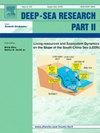Introducing a new method to determining the capacity of heavy metal absorption by macro algae on the coast of Persian Gulf based on Kullback-Leibler cumulative information
IF 3
3区 地球科学
Q2 OCEANOGRAPHY
Deep-sea Research Part Ii-topical Studies in Oceanography
Pub Date : 2025-02-19
DOI:10.1016/j.dsr2.2025.105466
引用次数: 0
Abstract
Researchers have continuously sought effective and affordable ways to address contamination. Application of both live and deceased algae biomass has emerged as a highly effective and promising approach for remediation. In this study, the efficacy of macroalgal species (Padina gymnospora, Cladophoropsis membranacea, and Hypnea hamulosa) harvested from the northern coast of the Persian Gulf was evaluated for their capacity to biosorb heavy metals, with a focus on nickel, lead, cadmium, and mercury. The study encompassed two key components. Firstlythe experimental methodology was meticulously design using Design-Expert software. Secondly, a novel approach involving – the analysis of scanning electron microscope (SEM) images of the algae was introduced, employing a measure known as cumulative Kullback–Leibler information. The results showed that P. gymnospora is capable of removing 50% of Pb. The highest percentage of Cd removal was observed in H. hamulosa (86.44%), while the highest percentage of Hg removal was recorded in C. membranacea (50%). Both, the experimental and analysis of image methods yielded consistent findings, corroborating their reliability. Based on the findings of this study, image analysis employing cumulative Kullback–Leibler information presents a novel and cost effective means of assessment, contributing to the arsenal methods available for contamination treatment.
介绍了一种基于Kullback-Leibler累积信息测定波斯湾沿岸大型藻类对重金属吸收能力的新方法
研究人员一直在寻求有效和负担得起的方法来解决污染问题。应用活的和死的藻类生物量已经成为一种非常有效和有前途的修复方法。在本研究中,研究人员评估了从波斯湾北部海岸收获的大型藻类物种(裸骨Padina gymnospora, Cladophoropsis膜藻和Hypnea hamulosa)对重金属的生物吸收能力,重点是镍、铅、镉和汞。这项研究包括两个关键部分。首先利用design - expert软件对实验方法进行了精心设计。其次,介绍了一种新的方法,包括对藻类的扫描电子显微镜(SEM)图像进行分析,采用一种称为累积Kullback-Leibler信息的测量方法。结果表明,裸芽孢杆菌对铅的去除率为50%。Cd去除率最高的是hamulosa (86.44%), Hg去除率最高的是C.膜藻(50%)。两种图像方法的实验和分析都得出了一致的结果,证实了它们的可靠性。基于本研究的发现,采用累积Kullback-Leibler信息的图像分析提出了一种新颖且成本有效的评估手段,有助于提供可用的污染处理方法。
本文章由计算机程序翻译,如有差异,请以英文原文为准。
求助全文
约1分钟内获得全文
求助全文
来源期刊
CiteScore
6.40
自引率
16.70%
发文量
115
审稿时长
3 months
期刊介绍:
Deep-Sea Research Part II: Topical Studies in Oceanography publishes topical issues from the many international and interdisciplinary projects which are undertaken in oceanography. Besides these special issues from projects, the journal publishes collections of papers presented at conferences. The special issues regularly have electronic annexes of non-text material (numerical data, images, images, video, etc.) which are published with the special issues in ScienceDirect. Deep-Sea Research Part II was split off as a separate journal devoted to topical issues in 1993. Its companion journal Deep-Sea Research Part I: Oceanographic Research Papers, publishes the regular research papers in this area.

 求助内容:
求助内容: 应助结果提醒方式:
应助结果提醒方式:


